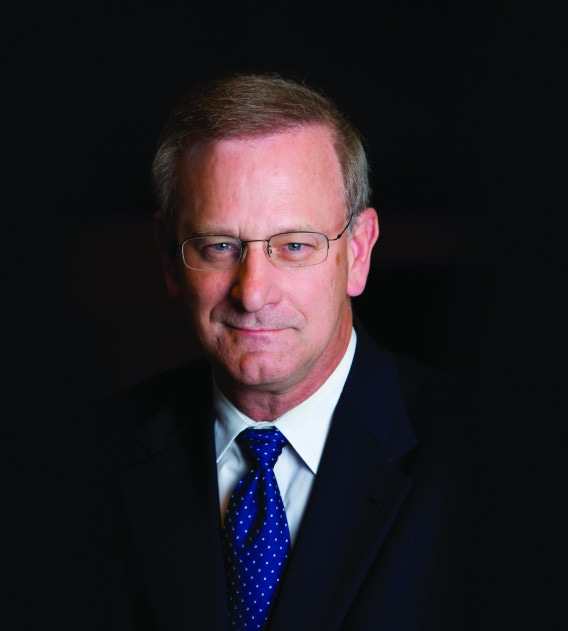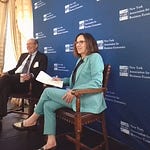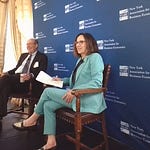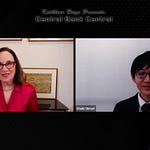Thomas Hoenig, former president of the Federal Reserve Bank of Kansas City who went on to serve as vice-chair of the Federal Deposit Insurance Corporation, arrived at the Shadow Open Market’s meeting in Washington this week with a bold plan to prevent the Fed from making what he sees as too-frequent policy errors. This as he joined the panel charged with answering the question, “How can the Fed best achieve its goals using available instruments?”
Tom has long been on the warpath when it comes to reining in banks that take on too much risk and end up having to be bailed out by the Fed, the FDIC and other bank regulators which often means taking steps at the expense of taxpayers and moves in financial markets that hurt investors. He also has argued that the Fed should rein in its steady purchases of Treasury bonds because this amounts to monetizing growing U.S. debt, in effect encouraging the Congress to keep spending more money rather than trying harder to rein it in.
His latest criticism of the Fed’s role in all of this, and what must be done to correct it, breaks with what many see as the most sacrosanct tenet of all surrounding the central bank: its independence from political influence. He argues that allowing the Fed to have unlimited discretion in setting its policy path - which is seen as the foundation of Fed independence - is letting it to make too many really bad errors in judgment. And he is proposing a plan where it would have to get approval from Congress if it has to move outside the broad policy band he proposes. The Fed would still have to keep inflation near its 2% target.
This is a clearly thought out and nearly heretical proposal meant to leave the Fed with sufficient freedom to act as it sees needed but makes it harder for it to take extreme actions on it s own.
Here is a link to the charts Tom used to illustrate key points he made at the SOMC conference:
https://shadowfed.org/wp-content/uploads/2025/04/Hoenig-Monetary-Policy-Rule-Conference_MC-Branded.pdf
Spoiler alert: Tom doesn’t expect this to be passed or even proposed any time soon. He says it will take another financial crisis to get a plan as radical as this to be put on the policy table.
Key elements for Fed policy success- 00:01:23:23
Independence is a big deal because the Federal Reserve is supposed to be able to say no to extreme policies. It's supposed to be able to say no to monetizing the debt. Those are important reasons for why it is independent, but it also is given a great deal of discretion in carrying out that responsibility, which means they can actually inadvertently support fiscal expansions when they perhaps shouldn't. When you have inflation as the risk ahead. And so, I'm saying within boundaries, I've set some wide boundaries that would limit the ability of the Federal Reserve in normal times.
Policy constraints for the Fed to limit discretion 00:01:53:16
We can define that in terms of how low or high interest rates can be set by them, and also how at what rate they can increase bank reserves for the industry to multiply loans by government debt and so forth?
The good can become the bad… and turn ugly 00:02:37:20
For example, the great financial crisis <the Fed> gave, they got involved in quantitative easing and that was in the crisis during 2008. It put a lot of money into the system and that was fine, except that after that it was in 2010, two years after the great financial crisis started and when they were in recovery, that they actually engaged again in quantitative easing and they did it again in 2013 and 2014.
Limit discretion by magnitude and time 00:03:07:10
So they were using discretion and the interpretation of their rights to engage in discretion, in extreme measures to use emergency powers during a recovery period long past when they should have been using (them) in my opinion. And so I'm saying that they should be able to use their extreme discretion in an emergency. But after six-months, they should either return to the boundaries that have been set, that could be and interest rates that are no higher than 5% or 6%, or less than 2% and growth in bank reserves from, say, 2 ½% to 3% to 4 ½% to 5%.
Look at the Fed during the pandemic as an example… 00:04:39:16
…you're talking about the pandemic and they engaged in extraordinary measures during the pandemic far beyond what they did, even in the great financial crisis, providing lines of credit to private to capital markets and so forth. And that set an expectation that they would do it in the future. And then they not only did it, they continued their policy. Well past the worst of the pandemic. In other words, the economy was technically in recovery in the fall of 2020, and yet they continued zero interest rates on for another year. And my rule would have said you could do it during the early part of the pandemic through the summer.
The lessons learned…00:05:26:19
But after that…<Post Crisis> you have to return to a more normal policy of interest rates above zero and bank reserves growing at a much lower rate than quantitative easing was allowing so that you don't - and you don't - cause inflation to balloon to 9% or <encourage> asset inflation to balloon as it did after the great financial crisis and after the pandemic.
Policies impact precedents & behavior 00:06:40:09
…what they did in 2023 is they provided unlimited liquidity to the banking industry and to other markets. And the one thing about that is they did it. It was beyond what the mandate was, because when they bailed out Silicon Valley, they bailed out all depositors, not just insured depositors. So they set a new precedent for banks that were, you know, less than 250 billion were bailing those out. So, you created another expectation there, and I think that has had harmful effects. Now, the expectation is you're going to bailout almost every bank except very little banks located in Oklahoma. That may be the exception where you don't bail out everything. And, otherwise, we're bailing them all out. So, you set the expectation around that.
Big picture constraints but with a lot of choice 00:08:09:08
The <Fed has> got to be in that that <rate> band <5% or 6%, or less than 2%>. And, secondly… bank reserves that they have a major influence on that increase between 3% and 5% on an annual basis. That provides plenty of liquidity into the system under normal circumstances. So, then you can use the Taylor Rule and the McCallum rule and all these things to help guide you between that 2% and 5 ½% on rates and that 3% and 5% growth in the reserves.
How this constrained system would work 00:09:01:23
They go, well, they can they can get into quantitative easing. They can lower interest rates as they need to for up to six-months. If they decide during that six-month period, they're going to need to go lower or longer than that, they have to go to Congress and pass legislation to say ‘yes, that your you're free to leave interest rates zero for another six months or another year,’ whatever they decide, and then you bring it back in.
It's about Fed independence, but Congress is in the loop 00:09:27:20
But it puts Congress in the loop because Congress is ultimately responsible and the Congress has to approve it and it has to be signed in. This legislation, whatever it comes in, is an emergency. I mean, this is kind of what I'm saying is you could Congress say, oh, we can't make up our mind. We've got to go back and forth? The Fed should be able to either solve the issue or make the case to Congress that they need that. And I think they can do that. I mean, look, we did it in the great financial crisis. Congress passed the TARP bill. <That would have worked>
But look at later on in 2010 and later 00:10:04:12
But let's say that then 2010 and the economy is in recovery. They've been in this expansionary period for well over six months. And they would have said, well, we want to do quantitative easing. Well, this one they would not have been allowed to do... They would have had to go to Congress. And I think there would have been a heck of a good debate in Congress before they would have been allowed to do that. And this whole concept, bizarre concept, is that something that could happen when a central bank is helping to buy all the bonds that the government is issuing.
Some of the pending proposals are frightening 00:10:44:04
And look what they're doing today. There is a proposal in play that you would exempt the banks from having hold any capital against government securities, which means that the banks can be warehouses for all this new debt creates deposits. They refund it buy the debt. The government spends the money redeposited with the banks, they buy more. There's no capital requirement. There's nothing. There's no reserve requirements. So, what we're doing is we're opening up an ever growing crowding out of the private sector with public debt.
Why this would work...and where this proposal is going 00:13:39:03
<This would work because…> The <Fed’s> discretion is bounded and therefore, they have to get Congress involved where it belongs. That's part of Congress's job under the Constitution. So why not do that? <and where is this proposal going?>… it will probably go nowhere except until there's another crisis. And they extend beyond <these parameters>… and we have another inflationary melt. Then maybe someone will look at it again. It usually takes a crisis to for change, doesn't it?
--
Thomas Hoenig
Thomas Hoenig is a Distinguished Senior Fellow at the Mercatus Center at George Mason University. Mr. Hoenig engages in research and comment on economics, money and banking, and related policy topics and provides economic outlook and related services to investment firms and businesses across the country.
Prior to joining the Mercatus Center, Mr. Hoenig served as Vice Chairman of the Federal Deposit Insurance Corporation from 2012 until 2018. In that capacity, he oversaw FDIC operations and policy related to deposit insurance pricing, bank supervision, and financial stability and bank resolution. He served as Chair of the FDIC’s Bank Appeals and Audit Committees, and served as Director of NeighborWorks America, which was established by Congress in 1978 to address housing issues nationwide. He also served as a member of the International Association of Deposit Insurers’ board from 2012 to 2017, and as the President and Chairman from October 2015 to October 2017.
Previously, Mr. Hoenig was President and Chief Executive Officer of the Federal Reserve Bank of Kansas City and a member of the Federal Reserve System's Federal Open Market Committee from 1991 to 2011. Mr. Hoenig was with the Federal Reserve for 38 years, beginning as an economist and then as a senior officer in banking supervision. As President and Chief Executive Officer, he led the Federal Reserve Bank of Kansas City during the Great Recession and the banking crisis of 2008 and 2009.
During his time with the Federal Reserve, Mr. Hoenig chaired several key committees including the Conference of Presidents, the Committee on Bank Supervision, Regulation and Legislation, and the Information Technology Oversight Committee. Also, during his tenure, Mr. Hoenig organized and hosted the Federal Reserve Bank of Kansas City’s Jackson Hole economic symposium for global central bankers.
Mr. Hoenig is from Fort Madison, Iowa and received a doctorate in economics from Iowa State University.














Share this post